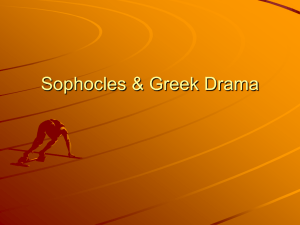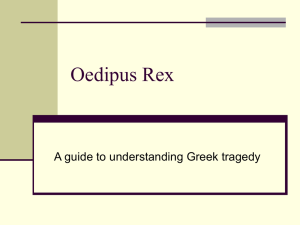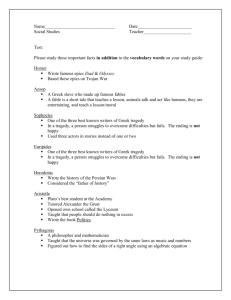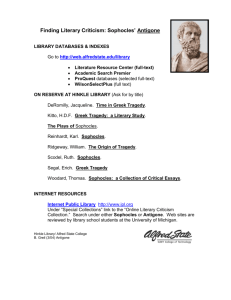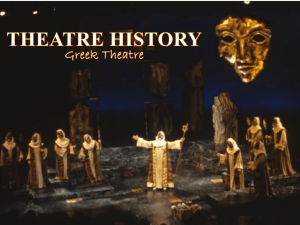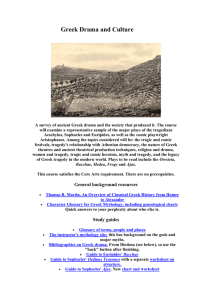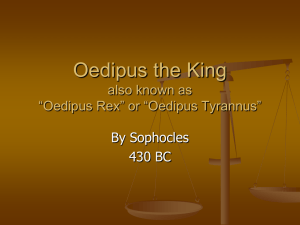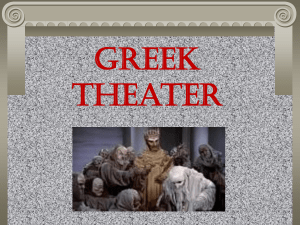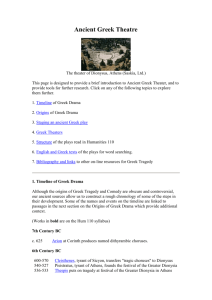C. The Greek tragedies
advertisement
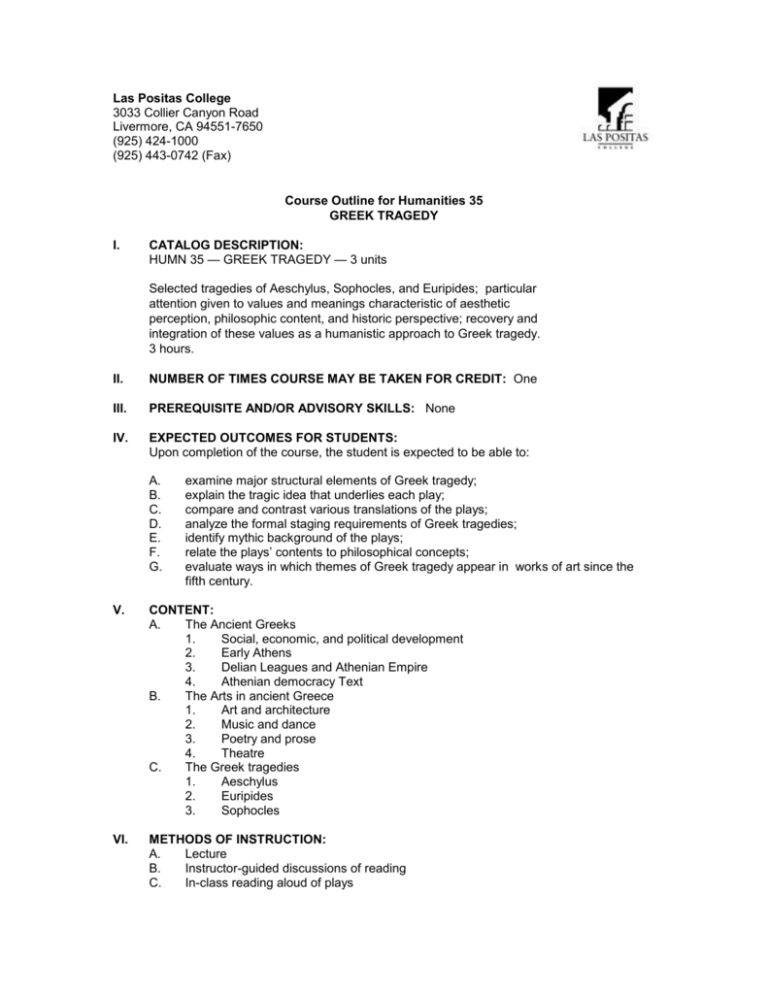
Las Positas College 3033 Collier Canyon Road Livermore, CA 94551-7650 (925) 424-1000 (925) 443-0742 (Fax) Course Outline for Humanities 35 GREEK TRAGEDY I. CATALOG DESCRIPTION: HUMN 35 — GREEK TRAGEDY — 3 units Selected tragedies of Aeschylus, Sophocles, and Euripides; particular attention given to values and meanings characteristic of aesthetic perception, philosophic content, and historic perspective; recovery and integration of these values as a humanistic approach to Greek tragedy. 3 hours. II. NUMBER OF TIMES COURSE MAY BE TAKEN FOR CREDIT: One III. PREREQUISITE AND/OR ADVISORY SKILLS: None IV. EXPECTED OUTCOMES FOR STUDENTS: Upon completion of the course, the student is expected to be able to: A. B. C. D. E. F. G. examine major structural elements of Greek tragedy; explain the tragic idea that underlies each play; compare and contrast various translations of the plays; analyze the formal staging requirements of Greek tragedies; identify mythic background of the plays; relate the plays’ contents to philosophical concepts; evaluate ways in which themes of Greek tragedy appear in works of art since the fifth century. V. CONTENT: A. The Ancient Greeks 1. Social, economic, and political development 2. Early Athens 3. Delian Leagues and Athenian Empire 4. Athenian democracy Text B. The Arts in ancient Greece 1. Art and architecture 2. Music and dance 3. Poetry and prose 4. Theatre C. The Greek tragedies 1. Aeschylus 2. Euripides 3. Sophocles VI. METHODS OF INSTRUCTION: A. Lecture B. Instructor-guided discussions of reading C. In-class reading aloud of plays Course Outline for Humanities 35 Page 2 GREEK TRAGEDY D. E. Small group discussions Artistic adaptations in art, music, film and other texts VII. TYPICAL ASSIGNMENTS: A. Reading: 1. Read Aeschylus’ Prometheus Bound and be prepared to explain the importance of this specific translation to your understanding and enjoyment of the work. 1. Read Euripides’ Medea and be prepared to compare the central character with other female characters in previously-read plays.Text B. Writing: 1. Write a brief essay describing how you might stage Eurpides’ Hippolytus. Relate your description to the formal requirements demanded for staging fifthcentury tragedy. 2. Write an essay in which you compare and contrast Euripides’ Alcestis with Gluck’s operatic adaptation. C. Collaborative learning: 1. In your small group, discuss, rehearse, and perform a scene from Aeschylus’ Prometheus Bound. 2. Choose another student with whom you can prepare and present a contemporary version of one of the tragedies studied or a contemporary piece which you think might structurally qualify as Greek tragedy. VIII. EVALUATION: A. Methods of evaluation 1. Examinations – midterm and final a. Typical question: short answer 1) Discuss the importance of the satyr play in Greek tragedy. b. Typical question: essay 1) Discuss Shakespeare’s understanding and appreciation of classical Greek tragedy as evidenced in one of his tragedies, e.g. Othello. 2. Weekly post-discussion short writing assignments: a. Typical question 1) Why does “the mask” as employed in Greek tragedy continue to fascinate us today? B. Frequency of evaluation 1. Weekly journal 2. Weekly post-discussion short writing 3. One small group presentation of a dramatic scene 4. One joint presentation of contemporary mythic application 5. Two written examinations (midterm and final) IX. TYPICAL TEXTS: A. Aeschylus. Prometheus Bound. Trans. by Scully, James and Herington, J.C. New York: Oxford UP, 1975. B. Euripides. Ten Plays. Trans. by Roche, Paul. New York: Penguin, 1998. C. Fine, John V.A. The Ancient Greeks: A Critical History. Cambridge, MA: Harvard UP, 1983. D. Sophocles. Antigone. Trans. by Braun, R.E. New York: Oxford, UP, 1973. X. OTHER MATERIALS REQUIRED OF STUDENTS: None Creation Date: 1993 Revision Date: 10/99 ; 3/06 Date Approved by Curriculum Committee: Course Outline for Humanities 35 GREEK TRAGEDY Date Approved for Distance Education: 11/09/05 Effective Date: Fall 2006 HUMN35.doc Page 3
